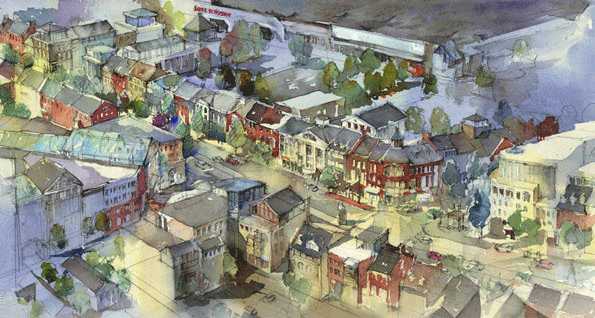Hamden, Connecticut. This project is the adoption of mandatory SmartCode form-based, mixed-use, mixed-income regulations impacting approximately 9,300 acres of former commercially zoned property. Surrounding residentially zoned property retains its conventional use-based regulations, though updated in the process. Unique to this project is how the form-base and use-base regulations are calibrated to form a hybrid where they meet so they blend seamlessly with one another at the margins.
Caught in the clutch facing towns across America, this town of 55,000 inhabitants had exhausted most all its developable commercially zoned property due to the voracious land grabbing appetite of conventional zoning. As a result, the tax burden to run the town had long been tapping at the door of residential property owners. Outrage against escalating property taxes had mounted to such deafening levels that town officials were left with little alternative but to cut expenses of useful public services and expenditures, such as schools, playgrounds, etc., and discouraging projects that might attract young families. The short horizon of this Ouroboros pattern was becoming all too apparent, making the prospect of increased tax revenue cause higher density, mixed-use development to become more palatable.
The award applicant reviewed the town’s entire zoning code, with the task of updating and removing conflicts and non-conformities in the residential zoning regulations, and changing all the commercial regulations to mixed-use, mixed-income SmartCode zoning regulations and regulating plan. The Applicant organized a five-day public Charrette in the Town Hall to vision the change from use-base to form-base regulations in the commercially zoned areas. At 9,300 acres, the submission’s commercial area ranks among the larger municipal areas in the country to adopt the SmartCode. Adoption of the SmartCode was positioned as a business incentive that will stimulate significantly higher densities on commercial properties as well as the inclusion of multiple uses, including mixed-income residential, dramatically boosting the business, economic development and tax revenue to the benefit all 55,000 inhabitants. In addition, the SmartCode provides incentives for development in lowering “risk,” by describing exactly what, where and how development will occur, which came out of the public Charrette so had the a priori stamp of public approval. The proscriptive (rather than restrictive) approval process will lead to significantly abbreviated approval times that translate into lower costs for developers.
After more than 2 years and 177 public meetings following the Charrette to consider as many public concerns from as many neighborhoods as possible, the Planning and Zoning Commission approved adoption of the new SmartCode regulations unanimously on December 7, 2009. The outcome is a mandatory SmartCode to replace the use-base code for the entire commercial area, and new regulating plans for all 9,300 acres that create new neighborhoods, a college town associated with Quinnipiac University, bustling street life to attract young adults, transit oriented development (TOD) at existing rail lines and through new proposed trolley lines, small lot affordability, traffic calming, a magnificent boulevard to replace a State highway, local agriculture, pedestrian oriented walkability, affordable solutions to hazardous waste issues in a former factory neighborhood, and an overall better sense of community throughout. In short, the town is on its way to becoming a better place to live, learn, work and play.




